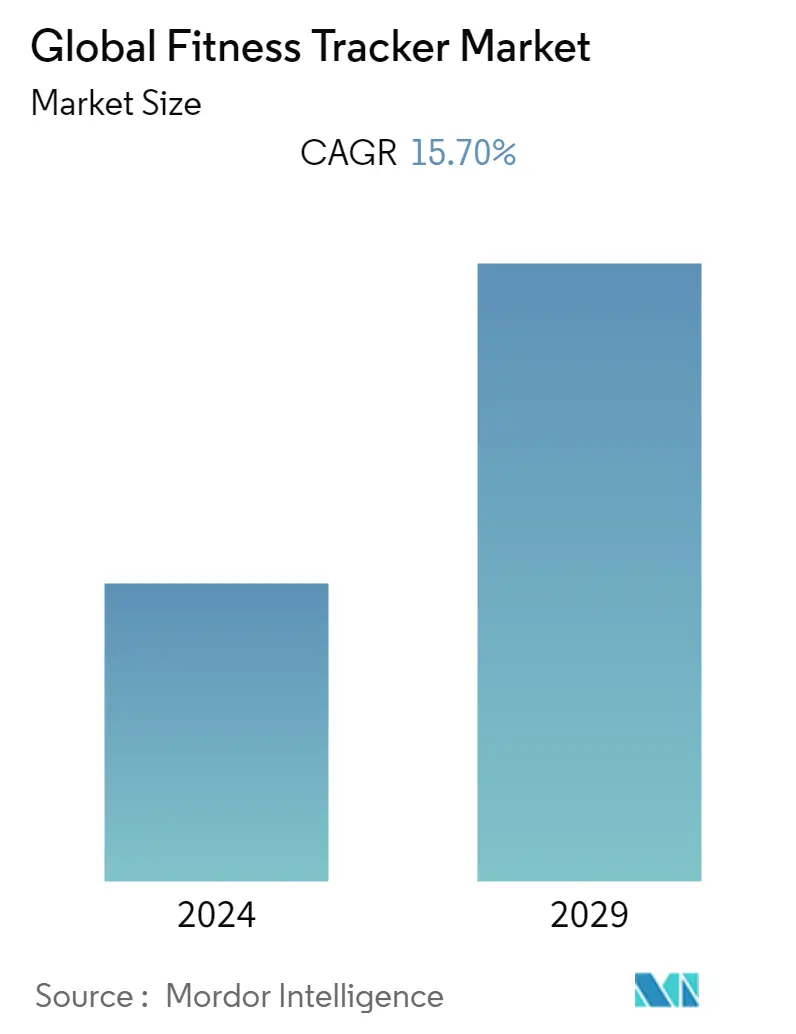Market Size of Global Fitness Tracker Industry

| Study Period | 2019 - 2029 |
| Base Year For Estimation | 2023 |
| Forecast Data Period | 2024 - 2029 |
| CAGR | 15.70 % |
| Fastest Growing Market | Asia-Pacific |
| Largest Market | North America |
Major Players*Disclaimer: Major Players sorted in no particular order |
Need a report that reflects how COVID-19 has impacted this market and its growth?
Fitness Tracker Market Analysis
The fitness tracker market is projected to register a CAGR of 15.7% during the forecast period (2022-2027).
During the COVID-19 pandemic, the demand for fitness tracker products has been seen increasing due to a lot of consumption and usage of these devices to monitor heart rate and oxygen levels in the body during the pandemic. This raise in adoption has resulted in increased research and development activities in the fitness tracker segment by the key players in this market. Furthermore, the demand for these fitness trackers has increased as these gadgets are also helpful in detecting COVID-19 cases in advance. For instance, according to a study conducted by Stanford University in California in 2021, smartwatches from Apple, Gramin, and Fitbit help detect Covid-19 cases before they show signs, among asymptomatic patients. Moreover, the Covid-19 pandemic has majorly increased awareness about these devices. The increased adoption has led to the rise in device development & innovation as more market players race in to deliver the growing demand and capture a higher market share. For instance, in August 2020, Fitbit Inc. launched Sense, an advanced smartwatch that features an ECG monitor, skin temperature sensor, stress management, sleep monitor, SpO2 levels monitor, built-in GPS, period tracker, and 20+ exercise modes. Thus, COVID-19 has a significant impact on the target market.
Certain factors which have contributed to the growth of the market include rising awareness among people on health, rising prevalence of cardiovascular diseases (CVD) and obesity, and growing penetration of the internet and smartphones among others. Many people are focusing on their health and are engaged in physical activities such as walking, running, cycling, and other recreational activities. Physical activity has been shown to aid in the prevention and management of non-communicable diseases such as heart disease, stroke, diabetes, and a variety of malignancies. It also aids in the prevention of hypertension, the maintenance of healthy body weight, and the enhancement of mental health, quality of life, and overall well-being.
The growing prevalence of obesity and other risk factors are expected to have a significant impact on the growth of the fitness tracker market as the awareness among the people is increasing with the advancement and easy availability of the tracking devices. For example, obesity is a major risk factor for various cardiovascular disease and as per the June 2021 update of the World Health Organization (WHO), the obesity prevalence have tripled since 1975, with about 39 million children of age below five years were obese in 2020 which is expected to increase over the years and that is expected to increase the demand of the fitness tracking devices as self-awareness and disease prevalence increases, therefore fueling growth in the fitness tracker market over forecast period.
Several studies have shown that obesity results in cardiovascular risk factors such as dyslipidemia, type 2 diabetes, hypertension, and sleep disturbances, thereby resulting in a higher prevalence of cardiovascular diseases and deaths across the globe. For instance, in December 2021, as per the International Diabetes Federation Atlas Tenth edition of 2021 report estimated that around 537 million adults (20-79 years) are living with diabetes. The total number of people living with diabetes is projected to rise to 643 million by 2030 and 783 million by 2045. Thus, for keeping track of heart rate the demand for fitness trackers is rising continuously. Additionally, the increasing product launches by major key players are further boosting the growth of the market. For instance, in June 2020, Xiaomi launched Mi Smart Band 5. Mi Smart Band 5 offers increased fitness tracking accuracy, women's health tracking, stress evaluation, and remote shutter control, among others.
Therefore, increasing health consciousness among people and the rising prevalence of cardiovascular diseases and obesity will result in higher adoption of fitness tracking gadgets among people, thereby propelling the market growth. While the Data security risks and the high cost of the product obstruct industry growth. During the COVID-19 pandemic, the supply chain got disrupted for months, which in turn has increased the prices of the products hampering the market growth. The strong price pressure on manufacturers and the high costs associated with high-quality fitness trackers pose a major challenge to market growth. Rising privacy and security concerns and fierce competition from other counterfeit products further obstructed the market growth. This coupled with the lack of a strong distribution network in lagging areas is expected to limit the industry growth over the forecast period.
